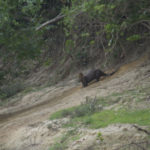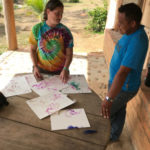
It has been awhile since the blog has been updated and I apologize for that! There is a good reason for the delay, however. Save the Giants has been incredibly busy planning and working to secure funding for the November trip which just took place and also for the upcoming February training and monitoring workshop. The November trip was great! Short, but we collected a bunch of new and interesting data as we started surveying different sections of the Rupununi River. Typically based of Karanambu, we ventured further south this visit to Yupukari Village, where we stayed at the Caiman House Eco-Lodge and Research center. The village is well known throughout the region for their commitment to conservation and we are so thankful to be joining the team! In addition to conducting our otter monitoring survey, we met with the village’s Tousha and came up with some great ideas for the upcoming February workshop. In February, we would like to structure our workshop to include breakout sessions that focus on wetland ecology, giant otter biology, ecotourism, water quality and one health issues that are escalating throughout the region. We are also bringing down enthusiastic artists from the States who will work with native, Guyanese artists to teach crafts to other community members. These crafts can be utilized in the development of merchandise that can be sold in village shops as an additional source of income.
If you have a few minutes, I encourage you to continue reading this blog entry, as I will try and summarize some of the biggest threats to both human health and the region’s wildlife/biodiversity. Hopefully this entry will help bring to light the importance of our work and why funding for this project is critical.
I try to stay positive in the blog posts and always highlight the “that was awesome” moments in the field. However, on this last visit down the gloomy cloud of reality was never too far in the distance. The wildlife trade, which I have spoke about before, is alive and thriving. The export facility in Georgetown that was previously shut down is now back up and running and the melancholy calls of parrots and chattery primates can be heard as you pass by on the road. It breaks my heart to know this facility, with floor to ceiling rusted caging that is full of scared and exposed wildlife, is once again operating. The horrible contrasting images of wild macaws, flying side by side with their mate clash with the images of crowded cages full of these beautiful birds; stressed out to the point that most of them have started plucking their feathers out. They pluck their feathers as a stress response and create large bald spots on their body which wildlife traders consider unsightly. Only the finest specimens can be shipped out to customers. For this reason, traders over harvest the birds (and other species); taking more from the wild than their permits allow to ensure that at least a few of the animals will still be in suitable condition come shipping time. What happens to the rest of the animals that are too shabby to be sent out…well, the facility is conveniently located directly over the inland waterway that connects with the Atlantic Ocean. An easy method of disposal for unwanted critters. The team of Save the Giants hopes to offset the pressures of the trade by educating local villages on the dangers of over harvesting wildlife and providing an alternative source of income, through eco-tourism and otter monitoring field ranger programs.
Another horribly disturbing development within the interior is the recent encroachment of rice farmers, who are leeching in from Venezuela and Brazil. Paddling along the river one day, close to the base of the Kanaku Mountains, we all stopped and looked at each other with confused glances as we listened to the sounds of an airplane flying low overhead. Where in the world was this plane going and where had it came from? There is only one flight service from Lethem to Georgetown and we were nowhere near the landing strip. These were the planes being used by rice farmers to spray chemicals on the savannas. When speaking with the Tousha of Yupukari, he made it clear that he had been trying for months to find out exactly what chemical was being sprayed. After contacting multiple government agencies with questions about the chemicals, he was left with nothing more than shrugs and “I don’t knows” from the persons he spoke with. Yupukari Village was not informed about the chemical applications, nor did they have a say in the matter. These chemicals ultimately end up in the river. A river which feeds, hydrates, cleans and provides recreation to villagers all along its banks. The effects of these chemicals on the villagers and the wildlife in the region are unknown at this time. By introducing water quality monitoring techniques, we are hopeful that we can assist the village in making and enforcing decisions regarding how their natural resources are managed.
The escalating tension between villagers and wildlife is becoming much more apparent along the rivers. Net fishing, which is illegal yet rarely enforced, is growing in scale. On any given trip down the river, you will see a handful of people casting nets that span all the way across the river from bank to bank. Often times, the nets are set in place and left overnight. Caiman, usually with no intention of doing so, tear holes in the nets or become entangled in them. This does not sit well with the fisherman who is trying to make a living off of his trade. There were several reports of floating, belly-up caiman, who were shot and killed by bow and arrow. These conflicts are not restricted to caiman. Otters are notoriously opportunistic feeders and when there is a net full of fish, otters will tear holes in the nets to grab what they can. Once again, fisherman do not look kindly on this behavior. It is my hope, that the otters are a bit more stealthy than the caiman and can continue to evade the fisherman. These stories of human/animal conflict are not new and will not go away without intervention. Save the Giants will be teaming up with local researchers who have been working on solving these types of conflicts. Together, we will work on interviewing villagers along the Rupununi using a one health assessment survey, developed to gauge perceptions towards wildlife. Using the data we collect, we will work with villages to come up with informed and sustainable solutions to some of these problems.
Having said all of that, here are a few of the highlights from the trip!
We were so happy to see some of our favorite otter faces on the river! We were also ecstatic to have our newest conservation biologist, Bridgette, join us in the field! She has been a tremendous asset to the team! With the giant otter knowledge she brings to the table and her fundraising capabilities, Save the Giants is pleased to welcome Bridgette onboard!













